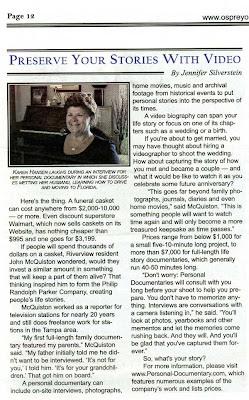Esquire magazine writer Cal Fussman, interviewing Robert De Niro, asked the actor if he had any regrets. De Niro said that he wished he had made a film about his family. But it was too late.
"When a parent dies," De Niro said, "it's the end."
Fussman wrote:
He told me he'd always wanted to chronicle his family history through his mother. He sensed a part of her wanted to do it, too, and he offered to send over some people to record it. But she was a little antsy, so he backed off. Not long afterward, she died. And what he wanted to preserve for his children was gone.
When I walked away from that lunch I knew exactly what I had to do. My own parents were about to celebrate their fiftieth anniversary, and my brother and I were throwing a party for them. We'd booked a banquet room in a hotel and invited family and friends. We figured we'd have good food, dancing, and some speeches. But now there was something else.
I got a tripod, mounted an ordinary video camera on it, and set it before my parents. I asked them about their marriage, their lives, and what they'd learned along the way.
I went out and filmed family talking about them. I filmed their friends. Then I got a college student to weave the best footage together and insert old photos. My brother jumped in to help edit.
We made a movie.
We broke this forty-five minute film into seven segments and showed it on a big screen at the party. It brought forth laughs. It brought forth tears. My parents called it the best night of their lives. I don't know if their great-grandchildren will ever meet them. But they will have that film.
At the end of the credits there was a thank you to Robert De Niro. It never would have happened without him.
It can be easy to overlook the stories that are right in front of you, or to think that no one would find them interesting, or to intend to do it "someday" only to see, as Robert De Niro did, that someday may be too late.
I've learned this too. I wanted to tell the story of my aunt and uncle. Thanks to my maternal grandfather's need to keep up with the Joneses, he owned a color motion picture camera and there are color films of both my mother and her older brother dating back to the mid 1940s.
My aunt was born in Germany as World War II began. Though she was young, she remembered the German surrender. The occupying Americans "were like saviors," she said. No wonder she later married an American.
Their story had great potential and the project sat on my "to do" list. Then I got an e-mail from a cousin. My uncle had died. I knew his health was poor but I thought I had more time. He was only 68. There's always tomorrow. Until there isn't.
Whether you do it yourself with a home video camera, as Cal Fussman did, or you hire us to do it, don't wait to tell your family's story. I can't promise that your parents will call the day they see their life story on video the best one of their lives. But I can guarantee that if their great-grandchildren never meet them in person, they will know them. They will have that film.
This clip from my own parents' life story video includes some of that old home film footage I mentioned above. Watch more examples of our work at Personal-Documentary.com.


